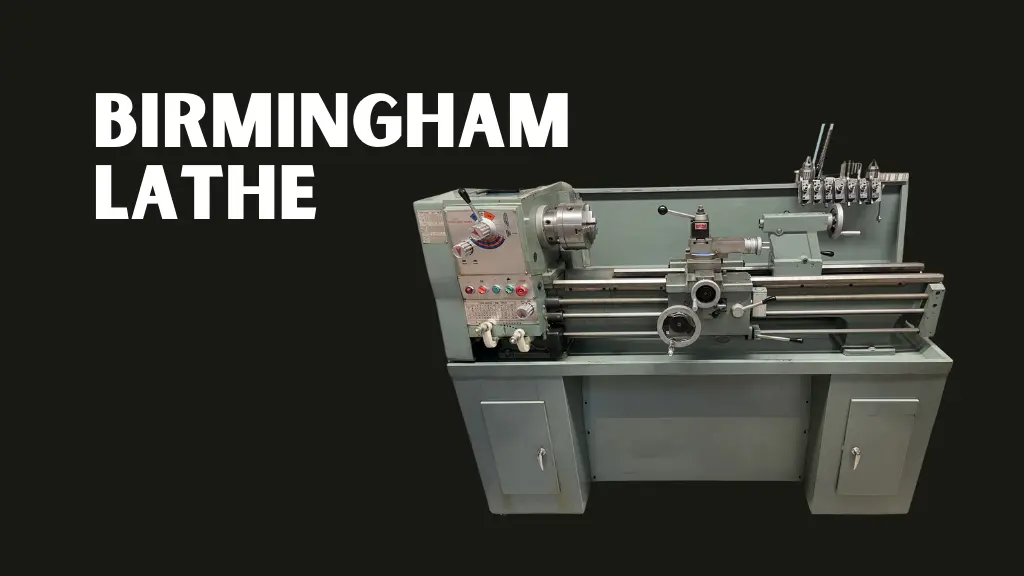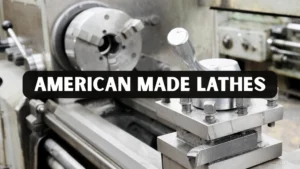If you are a machining enthusiast or a professional machinist, the Birmingham lathe is a tool that deserves attention. Known for its precision, durability, and versatility, these machines have been a favorite in workshops and hobbyist spaces for decades. This comprehensive guide explores everything from their history and types to key features, maintenance tips, and practical applications. By the end, you will have a clear understanding of why this machine is trusted worldwide and how to make the most of it in your workshop.
Introduction to Precision Lathes
Lathes are machines designed to rotate a workpiece on its axis, allowing operators to perform operations such as cutting, sanding, knurling, drilling, or shaping. Precision lathes are widely appreciated for their high build quality, smooth operation, and versatility across multiple machining tasks. For hobbyists, these machines provide the opportunity to create highly detailed projects, from miniature engines to custom tools. In professional workshops, they are trusted for producing durable and precise components used in engineering and manufacturing. Understanding how to use a precision lathe effectively can elevate both hobby and professional projects.
Birmingham’s Legacy in Precision Lathes
The story of this renowned lathe manufacturer begins in the United Kingdom, a country with a long tradition of engineering excellence. Over the years, the company established a reputation for producing reliable and precise machines suitable for both hobbyists and professionals. Their equipment became known for accuracy, durability, and innovative features such as variable speed control and precision threading, making it a trusted choice for a variety of users.
These machines gained global recognition, finding places in workshops, educational institutions, and private hobbyist spaces. Their enduring legacy is reflected not only in the quality of the machines but also in the trust and loyalty of users worldwide. This commitment to performance, innovation, and reliability has cemented the company’s position as a respected name in precision engineering.
Models of Birmingham Lathe
Understanding the different models is essential for selecting the right machine for your needs. Hobbyist models are perfect for small-scale projects, model making, and DIY applications. They typically feature compact designs suitable for limited spaces, moderate motor power for light to medium tasks, and variable speed control for precision. These machines are user-friendly, making them ideal for beginners learning the fundamentals of machining while experimenting with different materials.
Professional-grade models are designed for commercial workshops and manufacturing environments. They offer larger working capacities, higher spindle power, and advanced tooling options that allow machinists to perform specialized operations efficiently. These machines are trusted for high-quality production, providing reliability and durability required for long-term use.
Mini models provide a compact yet precise option for limited spaces. Commonly used for educational purposes, small hobby projects, and prototyping, they ensure accurate machining where precision is critical. Despite their smaller size, mini models maintain the same engineering standards and durability found in larger machines, offering a balance of precision, reliability, and versatility for both learning and professional applications.
Key Features and Specifications
Understanding the specifications and features of a Birmingham lathe is essential for maximizing its performance and longevity. Build quality is a critical factor, as a well-constructed machine provides stability, precision, and durability. High-quality lathes often feature heavy-duty cast iron beds, which reduce vibration during operation, and hardened steel spindles that maintain long-term accuracy. Precision-ground ways minimize wear over time and ensure proper alignment, which is vital for producing consistently accurate components.
Motor power and speed control are also key considerations. Lathe models typically range from 0.5 HP to 3 HP, allowing operators to work with a variety of materials effectively. Variable speed control enables fine-tuned operations without sacrificing precision, while smooth motor performance helps reduce vibration, contributing to high-quality results. Some advanced models include digital speed displays, providing real-time monitoring and adjustments to optimize machining performance.
Flexibility in tooling is another advantage of these machines. Users can attach tool posts, chucks, live centers, tailstocks, and faceplates to handle diverse tasks, while optional digital readouts enhance measurement precision. Dimensions and capacity vary: swing over the bed can range from 7 to 12 inches, the distance between centers from 12 to 36 inches, and weight from 200 to 1000 pounds. Selecting the appropriate size ensures safe operation, meets project requirements, and preserves precision during use.
Choosing the Right Machine
Choosing the right Birmingham lathe requires careful evaluation of your project requirements, workspace, and budget. Larger workpieces demand machines with greater swing and longer distance between centers, while smaller projects can be completed effectively with compact hobbyist models. Understanding the type of material you plan to work with is also crucial, as harder metals need more spindle power and a robust build, whereas softer materials can be machined with smaller, less powerful models. Considering these factors ensures that your investment meets your specific machining needs.
Workspace considerations play a vital role in lathe selection. A machine requires adequate room for safe operation, including space for accessories, material handling, and operator movement. Proper planning prevents accidents and improves efficiency in daily use. Hobbyists with limited space may prefer mini lathes, while larger workshops can accommodate professional-grade machines with higher capacity and advanced features.
Budget is another critical aspect to weigh. Hobbyist lathes are generally affordable and perfect for beginners who are learning the basics of machining. Professional-grade machines, although more expensive, provide enhanced durability, higher capacity, and advanced functionality, making them suitable for long-term commercial use. Evaluating project needs, workspace, and budget together allows users to choose a lathe that delivers reliability, precision, and efficiency for both current and future projects.
Maintenance and Safety Tips
Proper maintenance and safety practices are essential for prolonging the life of a lathe and preventing accidents. Regular lubrication of all moving parts reduces wear and ensures smooth operation, while thorough cleaning after each use prevents metal shavings and dust from causing long-term damage. Periodically checking the alignment of the spindle and bed helps maintain precision, ensuring every project meets exact standards. Consistent attention to these details safeguards the performance and reliability of the machine over time.
Operators should always wear appropriate safety equipment, including goggles, gloves, and suitable clothing, to protect against potential hazards. Electrical components must also be inspected regularly to prevent short circuits or malfunctions that could compromise safety. By following these practices, users create a secure and efficient working environment. Proper care and vigilance allow the lathe to deliver accurate, long-lasting results for every operation.
Applications in Hobby and Professional Work
Birmingham Lathe are highly versatile machines suitable for a wide range of applications. In metalworking, they can perform turning, threading, drilling, and shaping on various types of metals. Their precision allows machinists to achieve consistent results in both small and complex projects. This flexibility makes them a valuable tool for any workshop.
Model engineers often use these machines to create miniature engines, mechanical components, and custom tools. The accuracy provided by these lathes ensures that every piece fits perfectly and operates smoothly. Hobbyists can experiment with intricate designs without compromising on quality. This makes them ideal for detailed and delicate work.
Prototyping is another common application, as these machines allow precise production of parts for inventions and prototypes. Educational institutions also use them to teach machining techniques, giving students hands-on experience with real-world equipment. Their combination of accuracy, durability, and versatility makes them indispensable for both learning and professional projects.
Case Studies and Real-World Experiences
Real-world experiences demonstrate the value and capabilities of high-precision lathes. A hobbyist named John purchased a mid-sized machine to create miniature engine components. Its accuracy allowed him to produce pistons and cylinders with tolerances under 0.02 millimeters, significantly improving the performance of his engines.
In a professional setting, Smith Solutions, a small workshop in the United Kingdom, used a similar machine for producing custom metal components. The reliability and precision of the equipment reduced production errors by approximately 30 percent, resulting in higher client satisfaction and improved operational efficiency. These examples highlight how investing in high-quality machinery can positively impact both personal projects and commercial production, providing long-term value for users at all skill levels.
Conclusion
The Birmingham lathe remains a benchmark in precision engineering, valued for its reliability, durability, and versatility. It is suitable for hobbyists, professional machinists, and educational institutions, enabling high-quality work across a variety of projects. Understanding the different types of lathes, their key features, and proper maintenance practices helps users make informed decisions. With careful operation, this machine ensures consistent and accurate results for every task.
Investing in a high-quality lathe provides a tool that supports efficient, precise, and creative work for many years. Whether crafting miniature models, producing custom components, or teaching machining skills, users can rely on its performance. Its combination of sturdiness and precision makes it a trusted companion in any workshop. Proper care and use guarantee long-term professional-grade results without compromise.
Frequently Asked Questions
What materials can I machine?
These lathes can handle metals, plastics, and soft woods depending on the tooling used.
Are they beginner-friendly?
Yes, hobbyist models are designed with safety features and simple controls suitable for beginners.
How can I maintain accuracy?
Regular cleaning, lubrication, and checking alignment help maintain precision. Measuring tools such as calipers further improve results.
Can I use a lathe for wood projects?
Small-scale wood projects are possible with appropriate tooling. Proper technique ensures safe and accurate results.
What accessories do I need for different operations?
Tool posts, chucks, live centers, and faceplates allow you to perform various tasks. Optional digital readouts enhance measurement precision.




